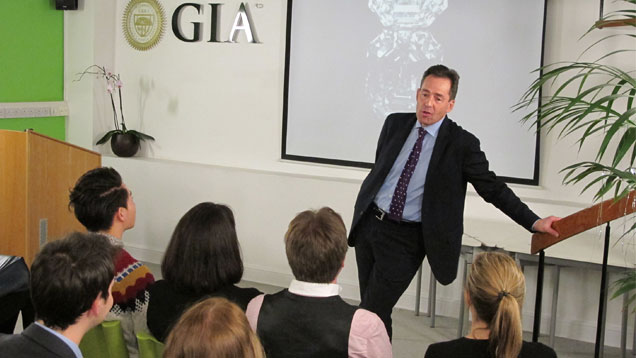From Elizabeth I to Elizabeth Taylor: Jewelry through the Ages
December 19, 2013

John Benjamin, a long-time contributor of the BBC’s Antiques Roadshow, promised a “personal account of 450 years of jewelry in one hour and four minutes” when he visited a GIA Alumni Association’s London chapter meeting in December 2013. He delivered that and more as he treated over 50 alumni members and guests to a presentation full of passion, expertise and humor.
Benjamin, an FGA and DGA with the Gemmological Association of Great Britain (Gem-A), started his career in 1972 at Cameo Corner, the celebrated Bloomsbury jewelers originally located a stone’s throw from GIA’s London campus. He worked for Phillips Fine Art Auctioneers for 23 years until he established his eponymous independent jewelry consultancy in 1999.
He began his presentation in the 16th century by describing the attitudes toward jewelry and why people wore it. Status, along with magical and religious associations, were strong factors in people’s choices for adornment, he said. Elizabeth I, who reigned from 1558-1603, was the ultimate power dresser, according to Benjamin. He illustrated his point with a famous portrait of her bedecked in gold and gems, especially pearls.
“She’s not just wearing jewelry, she’s groaning with it,” he said. “There’s so much on her, she might just fall over.”
He reviewed the 17th century, when the first imitation gemstones made from paste were introduced, and the 18th century, which welcomed opportunities to show the glamour of diamonds ‒ especially when viewed by candlelight. Diamond bow jewelry, with the stones from India and Brazil mounted in silver, was fashionable during the period.
Benjamin briefly touched on the sentimental, romantic look of the 1820s-30s; a period of nature and naturalism, such as a flower spray brooch, in the 1850s; and then tourist jewelry, created for Great Britain’s wealthy elite who started to travel, especially to Italy.
“Jewelry needs to be seen in the context of its time,” Benjamin said, noting the lively, yet elegant, animal and insect jewelry that was popular in the 1880s-90s. The end of the 19th century heralded the introduction of mass jewelry production, exemplified by the prevalent “tatty silver brooches” in the U.K.
The rise of the middle classes, Great Britain’s Empire and the discovery of diamonds in South Africa all contributed to a look that was all about diamonds from 1900 onward, he said. With the Kimberley discoveries democratizing diamond consumption, factories in northern cities, such as Birmingham and Chester, churned the goods out for an eager market. This led to the Arts and Crafts movement, a counterpart to commercialism. He cited brooches by the Gaskins as examples.
Benjamin said the most important change in jewelry design at the start of the 20th century was the introduction of platinum – it gave rise to many great European jewelry houses, especially Cartier. The advent of World War I ushered in a change in buying habits and shifted the main jewelry buying market to the U.S., which remains the largest consumer globally. He called out the Hope diamond as a classic example of this change, saying he could not imagine what the Hope would sell for if put on the market today.
The elegant jewelry of the 1920s and Art Deco in the 1930s gave way to very different and unusual designs in the 1940s-50s, with pieces that featured lots of colored gemstones, such as aquamarine, peridot, citrine and even zircon. Benjamin called this a defining era for women who were working and making their own jewelry purchases.
“What did they want to wear? Everyday jewelry in 9k gold; inexpensive and hard-wearing to suit their new lifestyles,” he explained. Jewelers in London’s West End, such as Asprey and Hancock’s, satisfied the demand.
Moving closer to the present day, Benjamin described the situation of the 1980s and 1990s as “What is real and what is not,” referencing the rise of synthetics and treatments that continue to escalate.
Benjamin predicted that the next look will be defined by jewelry with an ethnic and indigenous look, reflecting the integrity, style and essence of the country in which it was made.
Dennis Bellesort, GIA GG, a regular attendee and previous speaker, said he was pleased to hear Benjamin’s presentation. “He has a great eye for jewelry and possesses great words to express beauty,” he said.
Benjamin thanked the GIA Alumni Association by saying the evening had been particularly invigorating for him since there were so many young people in the audience.
“I wanted to excite you,” he said. “Jewelry and gemology is a lightning conductor into a fantastic career.”



